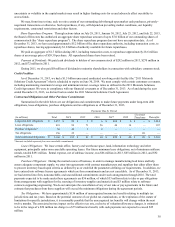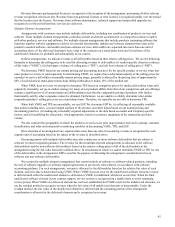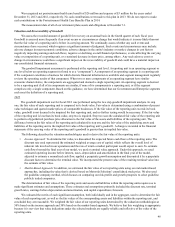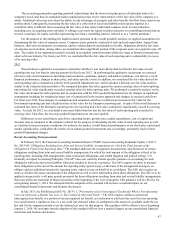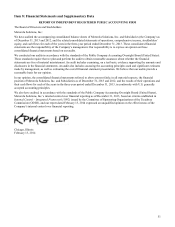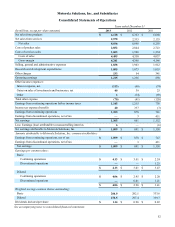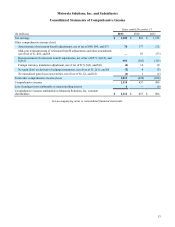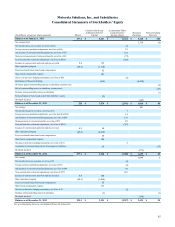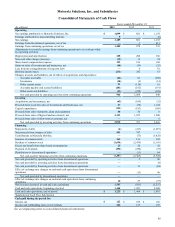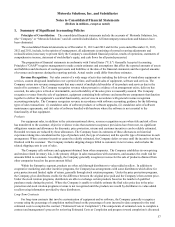Motorola 2013 Annual Report Download - page 49
Download and view the complete annual report
Please find page 49 of the 2013 Motorola annual report below. You can navigate through the pages in the report by either clicking on the pages listed below, or by using the keyword search tool below to find specific information within the annual report.
47
The accounting principles regarding goodwill acknowledge that the observed market prices of individual trades of a
company's stock (and thus its computed market capitalization) may not be representative of the fair value of the company as a
whole. Additional value may arise from the ability to take advantage of synergies and other benefits that flow from control over
another entity. Consequently, measuring the fair value of a collection of assets and liabilities that operate together in a
controlled entity is different from measuring the fair value of that entity's individual common stock. In most industries,
including ours, an acquiring entity typically is willing to pay more for equity securities that give it a controlling interest than an
investor would pay for equity securities representing less than a controlling interest, referred to as a "control premium."
For the purpose of determining the implied control premium in the overall goodwill analysis, we applied assumptions for
determining the fair value of corporate assets. Corporate assets primarily consisted of cash and cash equivalents, Sigma Fund
balances, short-term investments, investments, and tax-related deposits and refunds receivable. Judgments about the fair value
of corporate assets include, among others, an assumption that a significant portion of the corporate assets are required to pay off
debt. The results of our impairment analysis resulted in an implied control premium within the range of historical transactions
observed in our industry. For fiscal year 2013, we concluded that the fair value of each reporting unit is substantially in excess
of its carrying value.
2012
We performed a qualitative assessment to determine whether it was more-likely-than-not that the fair value of each
reporting unit was less than its carrying amount for fiscal year 2012. In performing this qualitative assessment, we assessed
relevant events and circumstances including macroeconomic conditions, industry and market conditions, cost factors, overall
financial performance, changes in share price, and entity-specific events. In addition, we considered the fair value derived for
each reporting unit in conjunction with the 2010 goodwill impairment test, which included a full step one fair value analysis
similar to the valuation discussed above. We compared this prior fair value against the current carrying value of each reporting
unit noting fair value significantly exceeded carrying value for both reporting units. We performed a sensitivity analysis on the
fair value determined for each reporting unit in conjunction with the 2010 goodwill impairment test for changes in significant
assumptions including the weighted average cost of capital used in the income approach and changes in expected cash flows.
For fiscal year 2012, these changes in assumptions and estimated cash flows resulted in an increase in fair value for the
Government reporting unit and a slight decrease in fair value for the Enterprise reporting unit. In spite of this small decrease in
estimated fair value of the Enterprise reporting unit, the reporting unit's fair value continued to significantly exceed its carrying
value. As such, for 2012, we concluded it was more-likely-than-not that the fair value of each reporting unit exceeded its
carrying value. Therefore, the two-step goodwill impairment test was not required.
Differences in our actual future cash flows, operating results, growth rates, capital expenditures, cost of capital and
discount rates as compared to the estimates utilized for the purpose of calculating the fair value of each reporting unit, as well
as a decline in macroeconomic conditions, the industry, the market, overall financial performance or our stock price and related
market capitalization, could affect the results of our annual goodwill assessment and, accordingly, potentially lead to future
goodwill impairment charges.
Recent Accounting Pronouncements
In February 2013, the Financial Accounting Standards Board (“FASB”) issued Accounting Standards Update (“ASU”)
No. 2013-04, “Obligations Resulting from Joint and Several Liability Arrangements for which the Total Amount of the
Obligation Is Fixed at the Reporting Date." The standard addresses the recognition, measurement, and disclosure of certain
obligations resulting from joint and several liability arrangements for which the total amount of the obligation is fixed at the
reporting date, including debt arrangements, other contractual obligations, and settled litigation and judicial rulings. U.S.
Generally Accepted Accounting Principles ("GAAP") does not currently include specific guidance on accounting for such
obligations with joint and several liability which has resulted in diversity in practice. The ASU requires an entity to measure
these obligations as the sum of the amount the reporting entity agreed to pay on the basis of the arrangement among its co-
obligors and any additional amount the reporting entity expects to pay on behalf of its co-obligors. The ASU also requires an
entity to disclose the nature and amount of the obligation as well as other information about those obligations. The ASU is to be
applied retrospectively to all prior periods presented for those obligations resulting from joint and several liability arrangements
that exist within our statement of financial position at the beginning of the year of adoption. This guidance will be effective for
us beginning January 1, 2014. We anticipate that the adoption of this standard will not have a material impact on our
consolidated financial statements and footnote disclosures.
In July 2013, the FASB issued ASU No. 2013-11, "Presentation of an Unrecognized Tax Benefit When a Net Operating
Loss Carryforward, a Similar Tax Loss, or Tax Credit Carryforward Exists." The ASU requires entities to present an
unrecognized tax benefit, or a portion of an unrecognized tax benefit, as a reduction to a deferred tax asset for a net operating
loss carryforward, a similar tax loss, or a tax credit carryforward when: (i) settlement in this manner is available under the tax
law and (ii) the company intends to use the deferred tax asset for that purpose. This guidance will be effective for us beginning
January 1, 2014. We anticipate that the adoption of this standard will not have a material impact on our consolidated financial
statements and footnote disclosures.



